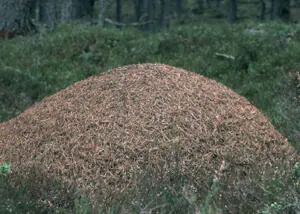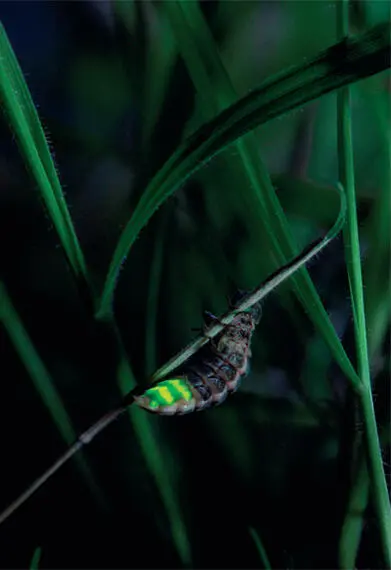During the summer months the surface of these nests can be a wriggling mass of thousands of ants busily carrying out their specific chores. The vast majority will be wingless workers, essentially immature females that take no part in reproduction. These differ in size between five and ten millimetres, according to the different jobs that have been preordained to carry out from the moment they emerge from their pupae. Some will spend their lives collecting honeydew – a saccharine substance found on the leaves of plants – or catching insect prey, while others will tend to the eggs, larvae and pupae, and a still different caste will have the responsibility of building and repairing the nest.
The sole egg-laying machine in the wood ants’ nest is the queen. She can usually be identified by her much larger thorax that houses the flight muscles, and an outsized abdomen, which contains the ovaries and a sperm sac from her single mating. Although the vast majority of her eggs will develop into the different worker castes, during spring, winged queens and males begin to emerge from slightly larger pupae. These ‘sexuals’ will take to the air and mate, after which the queens disperse to form new colonies away from the mother nest. Separate nests in the same wood are able to synchronise the release of their sexuals on the same day so that new populations have a shuffled combination of genes to avoid inbreeding. These synchronised flights of the winged wood ants will only occur during the right climatic conditions and the number produced can be vast as they rise into the canopy to mate on the wing or in the treetops. While many will be eaten, for example by insectivorous birds, the local predator population often becomes quickly swamped by this sudden surplus of food meaning that there is negligible overall impact.

An ant citadel, with a population slightly larger than Bristol and, arguably, far fewer traffic jams!
Laurie Campbell
After this mass aerial ant orgy, the males die and the females return to the ground, shed their now-obsolete wings and look for suitable nest sites. In the case of the Southern wood ant, the queen will track down a colony of a closely related species, the common black ant. She will then gather a few common black ant pupae and construct a special cell within the colony for them; upon hatching they will join their ‘stepmother’ in killing the original host queen. They will then look after the queen Southern wood ant’s eggs but, once the queen’s own eggs have hatched, the new Southern workers take over the colony and extinguish the original black ant colony!
The one and only mating from her nuptial flight will have provided the queen with enough sperm to last her entire life, which, in the case of wood ants, may be an astonishing fifteen years, during which time she may well lay hundreds of thousands of eggs. These eggs are placed in the warmest part of the nest until they hatch into hairless larvae. The larvae are then fed on a part-digested liquid meal by the workers, before they finally graduate on to prey items collected from the forest. As the larvae grow, they are meticulously looked after by the specialised workers while they undergo a number of moults until they are ready to pupate into either the workers or the sexuals.
Wood ants also use their incredible social organisation when, after a period of winter hibernation, the first few days of spring will be marked by an increase in activity and the workers can be seen pouring away from the nest along special pathways that they meticulously keep obstacle-free. In contrast to many ant species, which use chemical signals or pheromone trails to find their way, wood ants exploit their excellent eyesight; they use a combination of the shapes of the surrounding vegetation against the sky and the orientation of the sun. Foraging parties will then retrace their route back to the nest with their spoils.
Diligent ant researchers have extrapolated that, on a single warm summer’s day, a typical wood ant colony can bring back as many as 60,000 individual items to the nest; these include aphids, caterpillars, beetles, flies, harvestmen, woodlice and plant material. A daily haul of around 140 grams of solid food can have a serious impact on the wood, leading to so-called ‘green islands’ around nests, where the vast majority of the defoliating insects have been removed, meaning that the leaves remain virtually unblemished. A very important additional food source for wood ants is honeydew which is collected by the ants from aphids that have tapped into a plant’s sap. The wood ants will often protect their aphids from attack by ladybirds and, in return, effectively milk them, like we would our cows, for a reward of a tiny drop of sugar solution.
A substantial proportion of the daily items brought back will consist of leaves and twigs, or needles if the nest is under conifers, which will be used for running repairs to the nest. The nest is designed to keep out the rain, but is also constructed to catch heat to enable the ants to operate under conditions much warmer than that of the surrounding ambient air temperature. On the surface of the mound the temperature may vary by as much as 15°C in summer, but the heart of the nest can be kept at an incredibly constant and snug 25°C. Particularly in the first cold but sunny days of spring, it is thought that many ants will emerge to sunbathe before carrying the heat below to warm the nest.
The wood ant workers also have three formidable weapons to defend the nest against potential intruders and to subdue their insect prey. Like all ants they have relatively powerful jaws and huge supplies of formic acid, which can both repel borders and act as an alarm signal to the colony. Finally, the wood ants are able to rely on sheer numbers to help them overrun and subdue the enemy. If the surface of the nest is stirred up, large numbers of ants run to the disturbed point and curl their abdomens around to squirt the acid at the potential threat. Despite these defensive measures, significant numbers of ants will still often be consumed by green woodpeckers and badgers.
Away from the nest, territories may spread for close to 100 metres in all directions depending on the local competition. Ants can recognise colleagues from their own colony by a ‘nest odour’ and may viciously attack strangers; spring battles sometimes occur between some of the separate wood ant colonies as they delineate territories. Like all civilised societies, diplomacy will usually predominate if there is more than enough territory to go around, resulting in nests of many sizes and stages of maturity in favourable woods.
There can be few more delightful surprises for a naturalist than to walk along a country lane on a summer’s evening and to chance upon small pinpricks of luminous light emanating from the fields flanking the hedgerows. In addition to these unique biological lights being one of Britain’s most underrated wildlife spectacles, their function plays a vital part in the mating game of a fascinating insect.
Glow-worms
WHEN
Mid-June to mid-July
WHERE
More common in the south. Slapton Ley NNR, Devon; Barnack Hills & Holes NNR (Natural England), Cambridgshire; Aston Rowant Nature Reserve, near Stokenchurch, Buckinghamshire

Читать дальше














